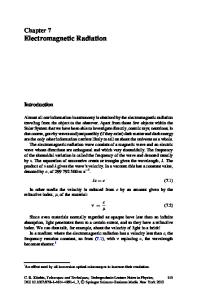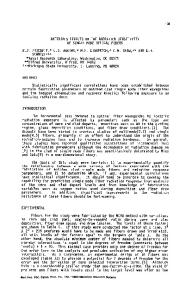The Effects of Low-Intensity Millimeter-Wavelength Radiation and Electromagnetic Shielding on Pain Sensitivity in Rats
- PDF / 497,761 Bytes
- 9 Pages / 612 x 792 pts (letter) Page_size
- 103 Downloads / 260 Views
LEX SYSTEMS BIOPHYSICS
The Effects of Low-Intensity Millimeter-Wavelength Radiation and Electromagnetic Shielding on Pain Sensitivity in Rats E. N. Chuyana, *, E. R. Dzheldubaevaa, and N. S. Tribrata a
Vernadsky Crimean Federal University, Simferopol, 295007 Russia *e-mail: [email protected]
Received November 29, 2019; revised February 10, 2020; accepted February 16, 2020
Abstract—Here, we studied changes in pain sensitivity in rats subjected to low-intensity millimeter-wavelength electromagnetic radiation (EMR MM) of 7.1 mm and 0.1 mW/cm2 in the occipital-collar region with daily exposure of 30 min over 21 days. As well, this radiation was combined with moderate electromagnetic shielding (EMS) which had the following parameters. The shielding coefficients of the constant component of the magnetic field along the vertical and horizontal constituents were 4.4- and 20-fold, respectively, with an exposure of 22 h/day over 21 days. The pain sensitivity was estimated with algometric tests, that is, the hot plate, flick-tail, and algesimeter-pincher tests; these allowed observation of the pain impulse at different regulatory levels. The algological effects of both individual and combined EMR MM and EMS were demonstrated. It was shown that EMR MM has an antinociceptive property when combined with EMS, as well as a modulation effect caused by shielding during hyperalgesia. At the same time, shielding reduces the antinociceptive effect of EMR MM. Keywords: pain sensitivity, millimeter-wavelength electromagnetic radiation, electromagnetic shielding DOI: 10.1134/S0006350920030033
The majority of non-biological environmental factors present electromagnetic radiation (EMR). Each region of this radiation spectrum plays its role in the evolution of living organisms and is involved in lifesustaining processes [1]. To support these data more information on the high sensitivity of biological systems to weak EMR of a nano- and pico-Tesla intensity is of significant interest [2–4]. However, electromagnetic effects of low-intensity factors on living organisms have been insufficiently studied. The millimeter-wavelength range of EMR (EMR MM) is one of the low-intensity electromagnetic factors whose biological effects have been studied with significant efforts. These effects do not cause organismal structural changes, are completely absorbed in the skin, and result in profound biological responses [5– 11]. Since the biological efficiency of EMR MM has been proven, this radiation is widely used in medicine to treat a variety of disorders of different origins [12, 13]. However, the mechanisms that underlie the effects of low-intensity EMR MM on biological objects are still to be revealed. Abbreviations: EMR is electromagnetic radiation; EMR MM is millimeter-wavelength electromagnetic radiation; EMS is electromagnetic shielding; PRLtft ispain response latency in a tailflick test; Fpul is mechanical pain threshold; PRLhpt is pain response latency in a hot plate test.
Active interference in organismal processes and studies on deprivation eff
Data Loading...











